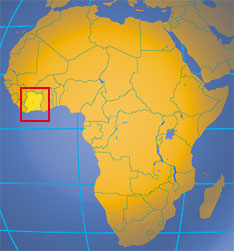The Republic of Côte d’Ivoire (English pronunciation: /ˌkoʊt dɪˈvwɑr/; French: [kot diˈvwaʁ]), commonly known in English as Ivory Coast, is a country in West Africa. It has an area of 322,462 km2, and borders the countries of Liberia, Guinea, Mali, Burkina Faso and Ghana; its southern boundary is along the Gulf of Guinea. The country’s population which was 15,366,672 in 1998, was estimated to be 20,617,068 in 2009.
Prior to its occupation by Europeans, Côte d’Ivoire was home to several important states, includingGyaaman, the Kong Empire, and Baoulé. There were also two Anyi kingdoms, Indénié and Sanwi, which attempted to retain their separate identity through the French colonial period and even after Côte d’Ivoire’s independence. An 1843–1844 treaty made Côte d’Ivoire a “protectorate” of France and in 1893, it became a French colony as part of the European scramble for Africa.
Côte d’Ivoire became independent on 7 August 1960. From 1960 to 1993, the country was led by Félix Houphouët-Boigny. It maintained close political and economic association with its West African neighbours, while at the same time maintaining close ties to the West, especially to France. However, since the end of Houphouët-Boigny’s rule, Côte d’Ivoire has experienced two coups d’état (1999 and 2001) and a civil war, although elections and a political agreement between the new government and the rebels have brought a return to peace. Côte d’Ivoire is a republic with a strong executive power personified in the President. Its de jure capital is Yamoussoukro and the biggest city is the port city ofAbidjan. The country is divided into 19 regions and 81 departments. It is a member of the Organisation of the Islamic Conference, African Union, La Francophonie, Latin Union, Economic Community of West African States and South Atlantic Peace and Cooperation Zone.
The official language is French although there are many other local languages, including Baoulé, Dioula,Dan, Anyin and Cebaara Senufo. The main religions are Islam, Christianity (primarily Roman Catholic) and various indigenous religions.
The country, through its production of coffee and cocoa, was an economic powerhouse during the 1960s and 1970s in West Africa. However, Côte d’Ivoire went through an economic crisis in the 1980s, leading to the country’s period of political and social turmoil. The 21st century Ivorian economy is largely market-based and relies heavily on agriculture, with smallholder cash crop production being dominant.
The country consists of a coastal lowland in the south, a densely forested plateau in the interior, and a region of upland savannas in the north. Rainfall is heavy, especially along the coast. There are over 60 ethnic groups in Côte d’Ivoire; the major groups are the Baoule, Beti, Senufo, Malinke, Anyi, and Dan. There are also a significant number of immigrants from neighboring Burkina Faso, Mali, and Guinea, as well as many people of Lebanese and French descent. The population is about 40% Muslim, with some 35% following traditional religious beliefs, and 25% Christian. The Muslims predominate in the north, while Christians are concentrated in the south. French is the official language. There are also some 60 native dialects, with Dioula the most widely spoken.
One of the wealthiest members of what was French West Africa, Côte d’Ivoire enjoyed a high economic growth rate from its independence through the 1970s. In the 1980s it faced economic difficulties, including a drop in commodity prices and huge foreign debt payments. Economic productivity and exports subsequently grew with the introduction of a market economy and International Monetary Fund-sponsored reforms, but since the late 1990s ethnic and political unrest have hurt the economy.
Despite steady industrialization since the 1960s, the country is still predominantly agricultural, with some 68% of the population engaged in farming. Corn, rice, manioc, sweet potatoes, and sugarcane are the main subsistence crops. Côte d’Ivoire is among the world’s largest producers and exporters of coffee, cocoa beans, and palm-kernel oil. Cotton, bananas, and pineapples are also raised for export. Mahogany and other hardwoods provide timber, which is also a valuable export, and the production of rubber has increased substantially in recent years. Livestock is raised in the savannas, and fishing is important. Among the country’s industries are the production of foodstuffs, beverages, wood products, textiles, and fertilizer; oil refining (offshore production of petroleum and natural gas began in the early 1980s); motor vehicle assembly; and ship construction and repair. There is some mining, including gold, diamonds, and nickel, but in 2005 the UN Security Council banned Ivoirian diamond exports because the gems financed the purchase of guns used in the country’s civil strife. Fuel, capital equipment, and foodstuffs are imported. France, Nigeria, and the United States are the chief trading partners.
In precolonial times the geographical area currently known as Côte d’Ivoire comprised many small states. The Portuguese established trading settlements along the coast in the 16th cent., and other Europeans later joined the burgeoning trade in slaves and ivory. In 1842 a French military mission imposed a protectorate over the coastal zone. After 1870, France undertook a systematic conquest; although a protectorate over the entire country was proclaimed in 1893, strong resistance by the indigenous people delayed French occupation of the interior.
Côte d’Ivoire was incorporated into the Federation of French West Africa, and several thousand of its troops fought with the French during World War I, but effective French control over the area was not established until after the war. Although Vichy forces held Côte d’Ivoire during World War II, many left to join the Free French forces in the Gold Coast (now Ghana). As the desire for independence mounted, Félix Houphouët-Boigny, a planter and founder of the federation-wide Rassemblement Démocratique Africain (RDA), formed (1946) the nationalist Parti Démocratique de la Côte d’Ivoire (PDCI). In the French constitutional referendum of 1958, Côte d’Ivoire chose autonomy within the French Community.
Notes from Wikipedia and Answers.com









